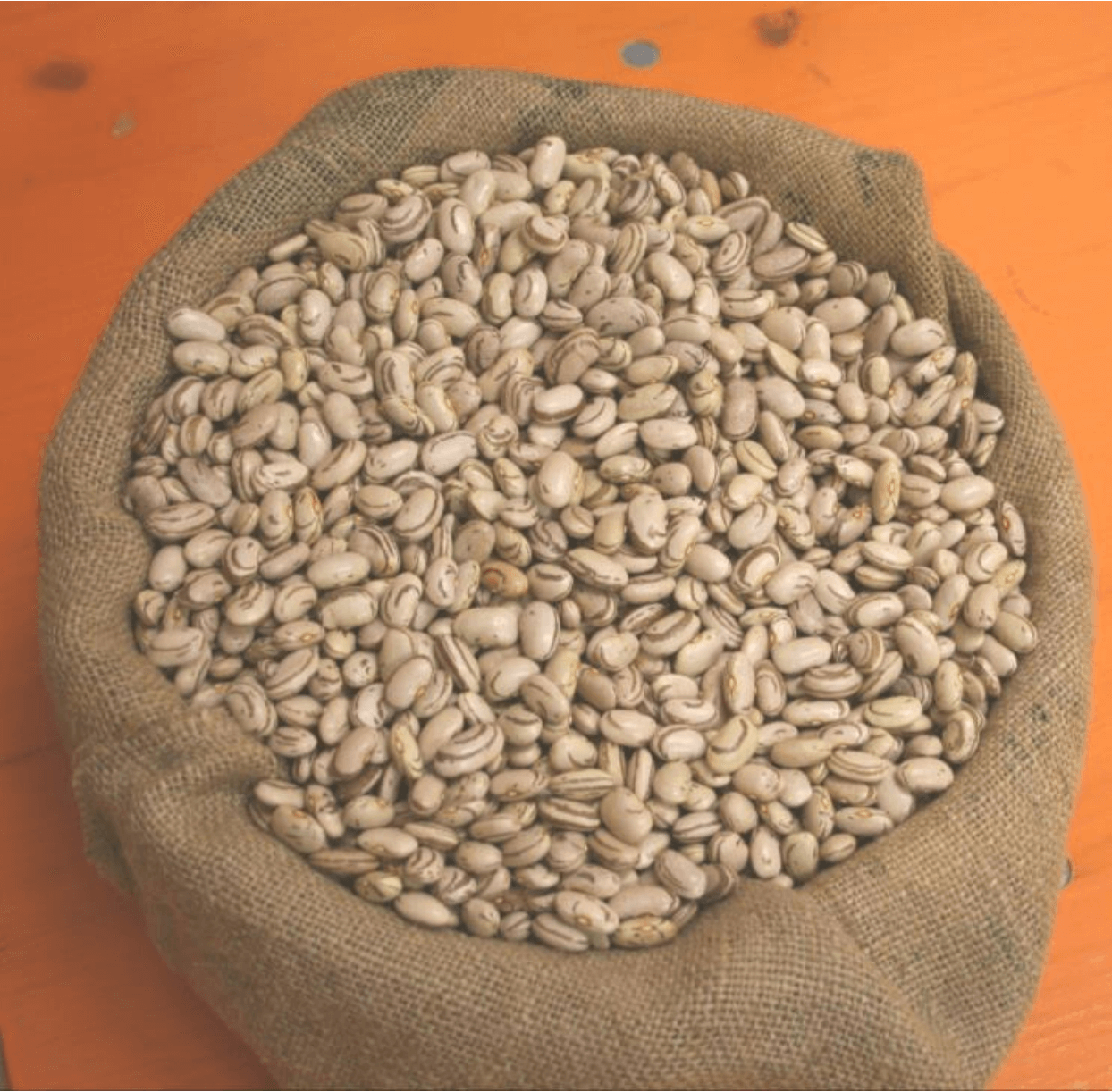Crop: Phaseolus vulgaris L. (Common bean)
It is not possible to establish when this landrace was introduced in the area as no official document reporting its cultivation has been found. However, the presence of this landrace has been testified by people living in the area, that reported its cultivation in the 30s.
The landrace is characterised by indeterminate growth habit (plant can be 3 m high). Flowers are typically pinkish-white. On average pods contain 5 seeds and are 144 mm long; pods are yellow, characterised by a stringy ventral suture. Hundred-seed weight is circa 70 g. Seed coat lighter colour is cream while the darker is brown.
The sowing is traditionally carried out in May (according to the moon phase). The cycle last 4-5 months and plants are harvested in September. The cultivation requires wooden supports and high availability of water; in fact, this landrace is also called ‘Fagiolo d’acqua’ by locals, literally ‘Water bean’.
Seeds of ‘Fagiolo di Camerata’ are characterised by a thin seed coat and highly appreciated tasting qualities.
Cultivation System: low-input conditions.
Geographical Information
Country: Italy
The cultivation of ‘Fagiolo di Camerata’ is limited to the district of Camerata, under the municipality of Todi (Perugia, Italy). In particular, the production is carried out in two places within the area: i) Campo Rinaldo and ii) Vocabolo San Pietro. Those two places are characterised by high availability of water and clay-rich soil.
Farmer(s) description:
Currently, within the area, no farm is cultivating ‘Fagiolo di Camerata’. The in-situ conservation of this landrace depends on few families that are still cultivating it in their gardens, producing modest amounts to cover their needs. Recently, the community of families cultivating this landrace started growing.
Propagation system: Seed, self-pollination
Multiplication procedures and consequences on landrace diversity:Traditionally, at harvest, gardeners select seeds collected from the lower part of the plant, that are generally bigger. Afterwards, the biggest seeds, characterised by more intense colours and seed pattern in both sides, are finally selected for the following season. In the past, farmers did not exchange their seeds. Currently, seed exchange is more frequent than before as it is mainly carried out to promote the cultivation of the landrace within the area.
As consequence of farmer selection procedures, the Landrace appears to be structured as a population in which differentiation among subpopulation is not clearly evident. A genetic and phenotypic characterisation would allow to establish the level of within-population diversity.
Management plan existence:The landrace management relies completely on farming activities in the area. Currently, no technical or scientific support is given.
Added Values
Currently, the cultivation of ‘Fagiolo di Camerata’ is carried out by locals who produce limited amounts, only for their home consumption. Initiatives are needed to promote the landrace on local and national markets.
Others (e.g. commercial/geographical brands or special traits):In recent years, in order to valorise the product, the local association named ‘Verdetodi’ has been promoting the use ‘Fagiolo di Camerata’ during their annual event ‘Todi Fiorita’, that takes place in the historical centre of Todi (Perugia) every year in mid-May. The valorisation is carried out by favouring local market and by providing people information on the traditional cultivation; indeed, the main scope of ‘Verdetodi’ is to valorise green culture in all its aspect by promoting sustainable environmental and agricultural practices.
In 2018 ‘Fagiolo di Camerata’ was included into the Regional Register of Landraces (Umbria Region, Italy), implementing the Umbria Region Law concerning the protection of local genetic resources (n. 25, 2001).
In 2014 the Department of Agricultural Food and Environmental Science of the University of Perugia carried out a morphological characterisation of the landrace; such activity favoured its registration into the regional register of landraces (Umbria Region, Italy).
In 2017, a project promoted by the local association allowed the distribution of several seed lots (35 seeds) derived from the last two accessions donated to the community by two gardeners that maintained the cultivation in situ in the last decades.
Accessions of ‘Fagiolo di Camerata’ are kept, under long terms storage conditions in the germplasm bank of the Department of Agricultural, Food and Environmental Science of The University of Perugia (FAO ITA-363).
An appropriate on-farm conservation of ‘Fagiolo di Camerata’ should ensure that subpopulations need to be maintained on the same farms in which the subpopulation has been developed through time. This would allow the landrace to maximise the conserved within-landrace genetic diversity.
Uncertain. To have access to the resource ‘Regione Umbria’ (http://www.regione.umbria.it/agricoltura) or ‘3A-PTA’ (http://www.parco3a.org/pagine/contatti-004) should be contacted.
Case study prepared by Dipartimento di Scienze Agrarie, Alimentari e Ambientali (DSA3), Università degli Studi di Perugia (UNIPG), Italy.
Most of updates have been communicated by Dr R. Torricelli (Università degli Studi di Perugia).
ND.
